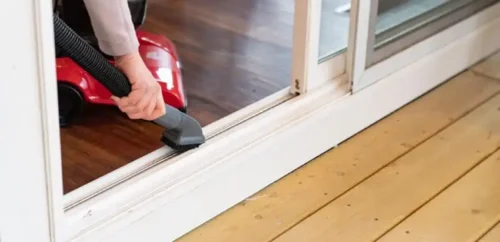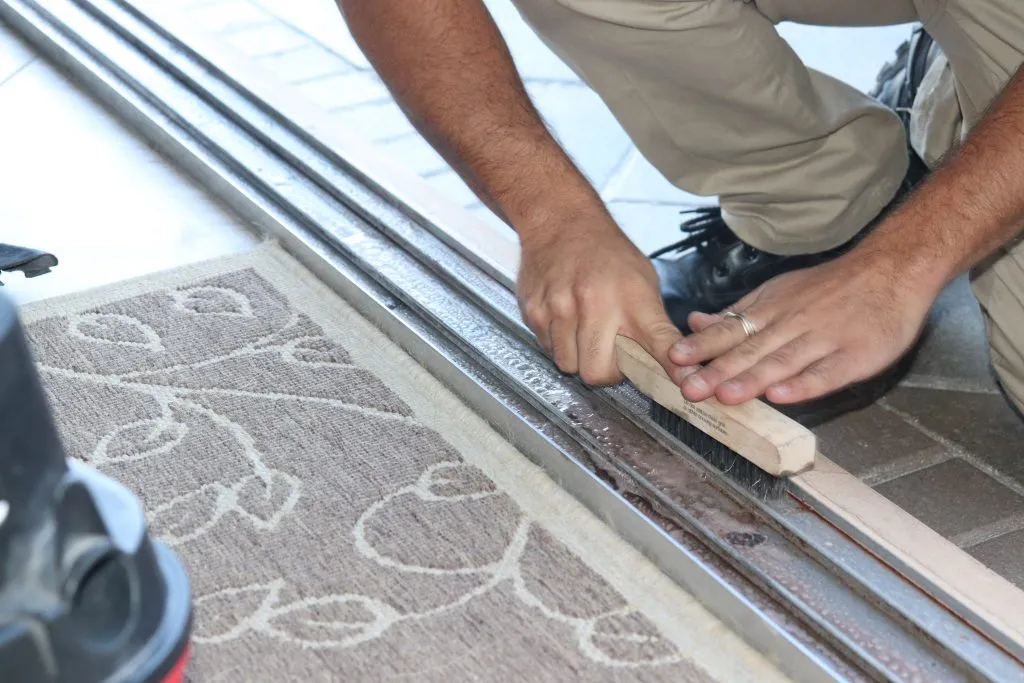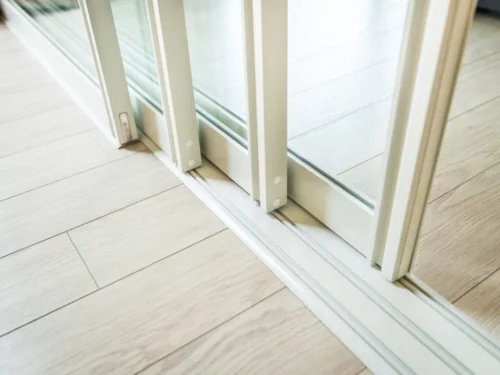Sliding door tracks might seem like a small detail, but they play a huge role in how your door functions. Over time, dust, pet hair, dirt, and debris build up in the tracks, making your sliding door harder to open or close.
This grime puts unnecessary stress on the rollers and frame, which can lead to costly repairs or early replacement.

Even worse, it can affect your home’s energy efficiency by preventing the door from sealing properly. The good news? A little routine care goes a long way. In this guide, we’ll show you how to clean sliding door tracks step-by-step, plus share smart tools and maintenance tips to keep things running like new.
Tools & Materials Checklist

Before you dive into cleaning, it’s best to have all your supplies ready. These simple tools will help you clean effectively without damaging the tracks or surrounding surfaces. Here’s what you’ll need:
-
Vacuum with a hose or crevice tool – to remove loose debris
-
Baking soda and vinegar – great for deep cleaning and dissolving grime
-
Or dish soap with warm water – a gentler alternative
-
Soft-bristle brush or old toothbrush – to scrub away stubborn dirt
-
Microfiber cloths or paper towels – for wiping and drying
-
Hydrogen peroxide – optional, for tougher buildup
-
Silicone-based lubricant – keeps your door gliding smoothly
-
Butter knife wrapped in cloth – perfect for cleaning tight corners
-
Gloves – protect your hands when using any chemical cleaner
Step-by-Step Cleaning Guide
Ready to bring your sliding door back to life? Let’s break it down into simple steps so you can clean those tracks like a pro. Each step helps reduce friction, prevent damage, and keep your door moving effortlessly.
Step 1: Inspect the Track

Before anything else, slide the door open and closed to check for any sticking, noise, or resistance. Look closely for dents, misaligned rollers, or damaged weather seals. Spotting these early saves you bigger repairs down the line.
Step 2: Vacuum Loose Debris

Use a vacuum with a narrow crevice tool to remove dirt, dust, pet hair, or leaves stuck in the track. If the nozzle can’t reach tight spots, try a DIY cardboard tube trick—flatten one end to suction around corners.
Step 3: Pre-clean with Soap & Water

Mix a few drops of dish soap with warm water and dip a soft cloth or sponge into it. Wipe along the tracks to break down surface grime and greasy buildup. Don’t forget to reach behind the door panels too.
Step 4: Deep Clean with Baking Soda & Vinegar

Sprinkle a thin layer of baking soda along the track. Then spray a 1:1 mix of white vinegar and water directly over it. Let it fizz and loosen stubborn debris for about 5–10 minutes. This chemical reaction works wonders on stuck gunk.
Step 5: Scrub with a Brush

Use an old toothbrush or soft-bristle brush to scrub the loosened dirt. Focus on corners, under the rollers, and anywhere buildup hides. Be gentle—scrubbing too hard might scratch the metal.
Step 6: Wipe and Rinse

Wipe down the track using a damp cloth or paper towel. For residue or leftover fizz, rinse lightly with clean water. Finish by drying everything with a microfiber cloth to prevent new grime from sticking.
Step 7: Lubricate the Tracks

Once the track is dry, apply a thin coat of silicone-based lubricant along the length. Avoid oil-based products like standard WD-40—they attract dirt. Slide the door back and forth a few times to distribute the lubricant evenly.
FAQs About Cleaning Sliding Door Tracks
1. How often should I clean sliding door tracks?
Clean your tracks at least every 3–6 months, or more often if your home gets dusty, or the door begins sticking.
2. Can I use WD-40 on sliding door tracks?
Avoid standard WD-40—it attracts dirt. Instead, use a silicone-based lubricant designed for sliding doors.
3. Do I need to remove the door to clean the tracks?
No. Most dirt can be cleaned with the door in place. Only remove it for deep cleaning or repairs.
4. What causes sliding doors to stick?
Sticking is usually caused by built-up dirt, debris, or lack of lubrication on the track and rollers.
5. What’s the best cleaner for sliding door tracks?
Use dish soap and warm water for general cleaning, or baking soda and vinegar for deep grime and mineral buildup.
Conclusion

Keeping your sliding door tracks clean ensures smooth operation, extends the door’s lifespan, and improves energy efficiency. With just a few simple tools and regular care, you can avoid costly repairs.
Make cleaning part of your seasonal routine. And if your door still sticks after cleaning, consider professional help or replacement.






![gray door with silver handle sign that says no - Are Aluminum Doors Better Than Upvc? [November 2025] - APRO gray door with silver handle sign that says no](https://aprowin.com/wp-content/uploads/2024/09/gray-door-with-silver-handle-sign-that-says-no-500x280.webp)
![Sliding glass doors opening to a poolside view in a living room - How Much Does a Door Cost? Door Installation Guide [2025] - APRO Sliding glass doors opening to a poolside view in a living room](https://aprowin.com/wp-content/uploads/2024/11/Sliding-glass-doors-opening-to-a-poolside-view-in-a-living-room-500x328.webp)
![Living room with sliding glass doors leading to a balcony - Standard Door Sizes: Essential Guide for Homeowners [2025] - APRO Living room with sliding glass doors leading to a balcony](https://aprowin.com/wp-content/uploads/2024/11/Living-room-with-sliding-glass-doors-leading-to-a-balcony-500x333.webp)
![Two garage doors with windows and overhead door mechanism - How to Adjust Garage Door Springs: Easy Guide [2025] - APRO Two garage doors with windows and overhead door mechanism](https://aprowin.com/wp-content/uploads/2025/02/Two-garage-doors-with-windows-and-overhead-door-mechanism-500x320.webp)
![Roller assembly being installed on a sliding window frame - How to Replace Rollers on Aluminum Sliding Door [2025] - APRO Roller assembly being installed on a sliding window frame](https://aprowin.com/wp-content/uploads/2025/01/Roller-assembly-being-installed-on-a-sliding-window-frame-500x489.webp)
![Exterior black aluminum bifold doors partially open - Aluminum Bifold Door Adjustment Guide | Tips [ 2025] - APRO Exterior black aluminum bifold doors partially open](https://aprowin.com/wp-content/uploads/2025/01/Exterior-black-aluminum-bifold-doors-partially-open.webp)
